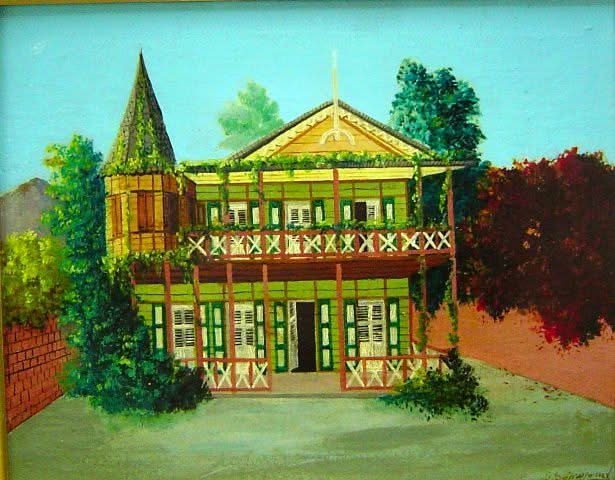Galland Semerand 12"x16" Gingerbread Oil on Canvas #17-3-95MFN
Galland Semerand 12"x16" Gingerbread Oil on Canvas #17-3-95MFN
无法加载取货服务可用情况
Description
Description
About this artist
About this artist
Gingerbread houses are an architectural style that originated in Haiti in the late 19th century. Gingerbread was coined by American tourists in the 1950s, who appreciated the style which bore similarity to that of the Victorian-era buildings in the United States. The movement of the style began in 1881 with the Haitian National Palace. In 1895, three young Haitians Georges Baussan, Léon Mathon and Joseph-Eugène Maximilien traveled to Paris, to study architecture and were inspired to build upon the nascent architectural movement and modified the style to the climate in Haiti by designing homes with vibrant patterns and flamboyant colors to the French resort architecture.[1]
The gingerbread house by design combines architectural knowledge that stemmed abroad, into an understanding of the Caribbean climate and its living conditions. They were constructed with tall doors, high ceilings, with steep turret roofs to redirect hot air above its inhabitable rooms, along with a cross-breeze of louvred shutter windows on all sides instead of glass to offset the most scorching of days, and flexible timber frames with the innate ability to weather some of the toughest storms, and tremors built with wrap-around verandahs.The houses are usually constructed out of wood, masonry, or stone and clay.[1][5]
This specific architectural heritage in Haiti is now seriously threatened as the natural aging of the wood, the weather, the high cost of restoration and repairs are all slightly favorable to the survival of this monumental. The style has been nominated to the 2010 World Monuments Watch.[1] However, only five percent of the estimated 300,000 houses were partially or fully collapsed due to the 2010 earthquake, compared to 40% of all other infrastructures that were considered to be in vital condition, which leaves U.S. conservation experts to believe that this architecture can be a model for seismic-resistant activity of the future. (Wikipedia). Guide To Prepare for Earthquakes
Own a piece of art by this artist? Each piece is unique. Get the actual estimated market value of yours Now! How Does It Work?
Want to know more about the wonderful art of Haiti? BUY NOW Your Haitian Art Book!
Can't find what you are looking for? Click Here To Ask Us!










